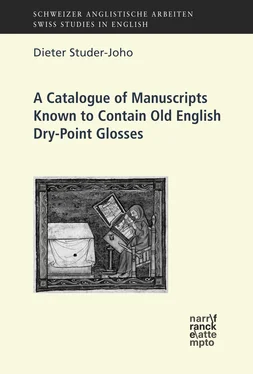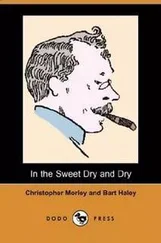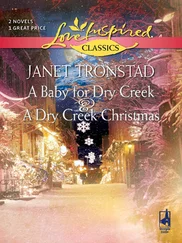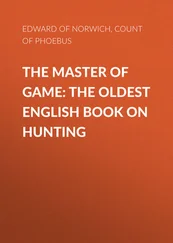1 ...6 7 8 10 11 12 ...19 Cambridge, CCC 57Cambridge, Corpus Christi CollegeMS 57 [3/K:34] also features some dry-point writing that is considered to represent a name.dry-pointnamesdry-pointrunes It consists of runic letters, set in two lines in the margin of f. 30 v, some of which may have been lost in the process of trimming. While the second line cannot be read with confidence, the first line is reported to spell out auarþ , which is considered to be the anglicised Scandinavian name “Hávarðr” (Graham 1996: 17). In addition to that, Cambridge, CCC 57 [3/K:34] also features 4 dry-point glosses to SMARAGDUS, Diadema monachorum , which is why the MS is included in the Catalogue below.4
Dry-point runesdry-pointrunesdry-pointnames spelling out the name Eđelþryþ are reported from St Petersburg, National Library of Russia F.v.I.8St Petersburg, National Library of RussiaF.v.I.8 [G:841] (also known as the “Codex Fossatensis”, sec. viii ex.or ix in., originating perhaps from Northumbria). The inscription is placed between the columns of the final page of the Gospel of John on f. 213 r.5
CLA (2: 183) reportsdry-pointinscriptions a short entry in Insular dry-point writing on the lower margin of f. 41 vof London, British Library Cotton Caligula A. xvLondon, British LibraryCotton Caligula A. xv [G:311], reading liofric sacerđ garulf leuita , which can be translated as “the priest Leofric [and] the deacon Garulf”; CLA dates it sec. ix or x and takes it as evidence that the MS must have been in England by then – originating from north-eastern France, sec. viii 2.
Small correctionsdry-pointemendations to the base text or to glosses consisting of single letters are also sometimes executed in dry-point. London, British Library Cotton Vespasian A. iLondon, British LibraryCotton Vespasian A. i[K:203] (also known as the “Vespasian Psalter”), for instance, features a dry-point letter added to the ink gloss OE gas ‘ghost, spirit’ (Pulsiano 2001: 737) glossing L. spiritus ‘ghost, spirit’ (Psalm 50:19). Such inconspicuous dry-point additions are not readily detected: It must be assumed that Sweet (1885: 258) did not notice the additional dry-point t and as a consequence marks the unusual form OE gas with an asterisk in his edition. While it can be argued that this t represents OE language material and hence constitutes an OE gloss (or at least part of it) in dry-point, I do not count this in as evidence of dry-point glossing activity in the “Vespasian Psalter”, but I think that this type of entry is more fruitfully termed “dry-point emendation”. After all, it can be argued that the extra does not gloss the L. text, but it emends the original gloss gas , about whose form we can only speculate. It may well be that the lack of the final in the original gloss may be due to a simple scribal error.
Interestingly, Toon (1991: 91) also reports dry-point compilation marksdry-pointcompilation marks from the “Vespasian Psalter” [K:203] on ff. 12 r–26 r, consisting of single letters taken continuously from the Roman alphabet. He assumes that the marks “take on meaning as notes made before the text was written and that helped a scribe lay out a plan for having the book copied, as he or she guessed how much space was needed for the text of the psalms” (Toon 1991: 91). They are reminiscent of the compilation notes that Schipper reports from the “Benedictional of St Æthelwold” [G:301] (cf.p. 51 below).
A runic dry-point entrydry-pointrunes whose inner connection with the base text is difficult to assess has been edited from Exeter, Exeter Cathedral 3501Exeter, Exeter Cathedral 3501 [K:116] (also known as the “Exeter Book”). Förster (1933: 64) mentions a runic dry-point entry incised in the top right margin of f. 125 rof the “Exeter Book”, next to the riddle 62/64 with the reputed solution “ship” (Williamson 1977: 105 [no. 62]; Muir 2000: 361 [no. 64]). Förster transliterates it as “BUGRД, but he takes the view that this runic entry and other marginal notes were added long after the “Exeter Book” had been written and he suggests an early-modern date of entry, “perhaps of the 17 thcentury” (64). Williamson (1977: 327) disagrees with Förster’s reading of the third rune and suggests ᛒ ᚢᚾᚱᚦ “B UNRÞ”, instead, also stressing the slightly larger spacing after the first rune. Williamson disagrees with Förster’s view that the entry was not genuinely medieval, but sees it as Old English, implying a date of entry still in the Anglo-Saxon era. Williamson ( ibid. ) reports that R.I. Page suggested to him “mischievously” in private communication that the runes might stand for OE beo unreþe , which he translates as “don’t be cruel” and hence as a comment on the difficulty of the riddle. Williamson provides a photograph of the runic dry-point entry (1977: 59 [Pl. XVII]), probably photographed under grazing light conditions. The individual runes are well discernible in the picture and the assumption that we deal with runic N seems more convincing than runic G, as one of the staves is upright with respect to the direction of writing and the other stave is slanting from top right to bottom left. Muir (2000: 708) interprets this way of writing the N rune as an error and deems it possible that the rune might in fact represent A, comparing it to similar forms on the Jelling Stone. Based on Williamson’s photograph, I cannot notice anything unusual about the form of the N rune, rather it seems mirrored along the vertical axis, which is not unusual in runic writing at all (cf. Page 1999: 41; Düwel 2001: 10 [“Wenderune”]). Muir (2000: 708) also points out that the final thorn rune is rather bottom-heavy and might as well be construed as a wynn rune <���ᚹ>, but he does not present a possible reading with final -w . In any case, the actual connection between the inscription and the text of the riddle does not become apparent, even though the riddle itself contains several runes, which might have inspired the use of runes in the dry-point annotation. In view of the other examples of runic names entered in dry-point in Anglo-Saxon MSS mentioned above, a reading of the runes as a name would be imaginable, too, but no immediate reading springs to mind, unfortunately.
In addition to this runic dry-point entry, the “Exeter Book” contains several dry-point etchings, some of which were even reproduced as actual dry-point etchings in the 1933 facsimile (Chambers et al. 1933). Conner (1986: 236–237) disagrees with Förster’s late date for the dry-point sketches, based on the observation that in four of the drawings “the writing goes over the drypoint lines”, which he takes as evidence “that these drypoints and surely others in the same styles were on the parchment” before the writing was added in the third quarter of the 10 thc. Conner presents a list of the dry-point drawings in the “Exeter Book” (Conner 1986: 237; enlarged in Conner 1993: 122), including “two large initial eths in the right margin of f. 80 r” and “two ornate initial P s (one above the other)” on f. 95 v, and he argues that their absence in his hypothesized first collational “booklet” can serve to differentiate it from the other “booklets”. However, Muir (1989: 277–279) refutes Conner’s observation by reporting previously unnoticed dry-point etchings in Conner’s hypothesized first “booklet”, some of which may represent letter forms: “perhaps including eth and wynn ” and others “most closely resembling an O and a P ” on f. 47 v.6 Interestingly, Alger (2006: 153) also reports a previously unnoticed beginning of a dry-point alphabet plus several worn letter-like dry-point etchings on f. 49 vof the “Exeter Book”.dry-pointalphabetical inscriptions The crude forms of the letters lead Alger to the conclusion that the glossator was merely practising letterforms, which are made up of mixed Insular and Caroline minuscules. None of the commentators can make perfect sense of the dry-point annotations vis-à-vis the base text. They do not seem to gloss anything as such, but the fact that even after Förster’s, Conner’s and Muir’s thorough searches for dry-point material, Alger (2006) was still able to find previously unreported etchings seems worth noting.
Читать дальше












